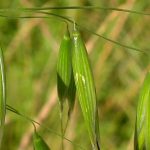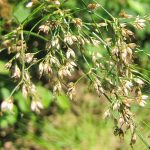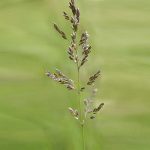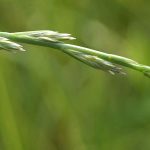- >>
- Birds Online – English
- >>
- Nutrition
- >>
- Healthy bird food from...
- >>
- Native grasses and cereals
Native grasses and cereals

A very tasty addition to the diet of many pet birds are native wild grasses and some grains, which are basically nothing more than certain cultivated forms of species from the botanical family of grasses. Most budgies and many other bird species are happy to eat grasses collected from nature, often without a long acclimatization period. One of the reasons for this is certainly that, especially for seed eaters such as budgies, the half-ripe grasses come very close to the natural food of their wild relatives – in Australia, wild budgies mainly eat half-ripe and ripe Spinifex grass. In my experience however, other bird species, whose wild relatives are not necessarily seed eaters, are also very fond of half-ripe grasses. It is probably the sweet taste of our native grasses that appeals to the birds.

Compared to ripe seeds, semi-ripe grasses contain considerably less fat. They are easy to digest and are therefore even eaten in many cases by birds that are suffering from painful digestive diseases. Half-ripe grasses are therefore a healthy food for most birds and a good “diet food” in case of illness, which does not burden the digestive tract. It is also good for “the slim line”. Served during the rearing of young, half-ripe wild grasses are a valuable feed for both adult birds and young chicks because, as already explained, they are easy to digest and contain a number of nutrients that are important for both chicks and adult birds.
Further down on this page you will find a list of associated chapters describing some common and widespread wild grass species and important grains. This chapter also provides some basic details about collecting and feeding wild grasses.
Click on the list entries to go directly to the relevant sections:
- Attention, allergens!
- Where should you avoid collecting grasses?
- Tips for collecting and storing
- Small animals on grasses – dangerous or not?
- Serving wild grasses
- Descriptions of some cereals and grasses from Central Europe
Attention, allergens!

However, collecting and offering grasses is not a pleasure for everyone. If you are allergic to pollen or if someone with a pollen allergy lives in your household, this food is unfortunately not particularly suitable for your pet birds for safety reasons. And even if you have no problems with pollen yourself, you should give any visitors fair warning if you regularly feed your birds wild grasses. Even thorough washing of flowering grasses (which you should definitely do) hardly helps and pollen is released in the home, which can become a problem for sensitive individuals. Half-ripe grasses generally no longer release pollen and are therefore not as big a problem for allergy sufferers as flowering grasses.
Where should you avoid collecting grasses?
It is best to collect grasses where there are no pollutants in the soil (some fallow land has soil contaminated with heavy metals) and where no pesticides have been able to get onto the grasses. Pesticide contamination could be present near areas that are used intensively for agriculture. The same applies in the vicinity of private gardens if pesticides from garden centers have been used there. It is also not advisable to harvest half-ripe grasses in places that are heavily frequented by dog walkers with their dogs, because bacteria can get onto the plants with the dog urine and excrement.
It is often assumed that plants on roadsides come into very close contact with exhaust fumes. This used to be the case, but since stricter standards have been introduced, the level of pollutants in plants on roadsides has fallen significantly. Nevertheless, to be on the safe side, plants should not be collected there as there is a risk of being hit by a car.
Tips for collecting and storing

When harvesting wild grasses, it is advisable to have a pocket knife or a pair of scissors and a piece of string with you to tie the grasses into bunches on the spot. You can easily store these bunches in a flower vase for three to four days. It is important that you place the grasses in the vase without the fixing string and change the water and wash the stems every day. This will prevent the stems from becoming moldy.
Most types of grass can either be dried when half-ripe to preserve them for a few weeks to months or they can be frozen for the winter. They can be removed later in portions, which is very convenient. However, you should only feed fully thawed plants to your birds.
Ripe grasses can be stored in a cool, dry place, protected from dust. It is advisable to allow them to dry out well for a few days in an airy place before storing them.
Small animals on grasses – dangerous or not?

Time and again, bird owners contact me with the question of whether all grasses can actually be fed without any problems. The vast majority of our native species belong to the botanical grass family Poaceae and are not poisonous. They can be fed without worry as long as they have not come into contact with problematic or toxic substances such as pesticides.
In most cases, there is also no need to worry about small insects and other tiny animals that may still be in the grass after it has been thoroughly washed. As a rule, they are not poisonous, but at most taste a little bitter. Aphids, on the other hand, are actually very sweet because of the honeydew in their stomachs. Some of my birds therefore love them as an animal snack.
If you don’t necessarily want to bring lots of small animals into the house with the grasses, you should shake the stalks out vigorously when harvesting outside and repeat this several times. Most of the small animals will fall off on the spot and can look for a new plant to survive on.
Serving wild grasses

For feeding, I either “weave” the grasses into the top of the cage or I attach them at the long stalk with a clip designed for closing freezer bags. This prevents the grasses from slipping around too much. I cannot recommend attaching them with a clothespin, as some bird owners do. The birds could slip into the clips with their toes while feeding and injure themselves. This risk does not normally exist when using the freezer bag clips. Nevertheless, it is important to keep an eye on the birds. In addition, too many blades of grass should not be fastened at the same time, as this can cause the clips to bend open too much. This creates small gaps in which the birds’ claws can get stuck in. It is therefore better to have several clips ready and attach small portions at a time. Caution: Large parrots could bite pieces off off these clips, which is why they are only suitable for use with small pet birds.
Tip from Silvia Berkemeier, May 2010

I put fresh grasses in a wicker ball woven from bamboo, willow twigs or simila. Such balls are usually available in the rodent section of pet stores. The wood is usually so tightly woven that the budgies can’t get any part of their body stuck in it I attach the wicker ball to the cage roof with a short wire so that it doesn’t roll back and forth but still moves. The budgies climb around on the ball, which sometimes moves a little, and pluck out the grasses. Perhaps other budgies will also enjoy this activity, which is a lot of fun for my birds.
Descriptions of some cereals and grasses from Central Europe
Be aware of ergot fungus
Barnyard Grass (Echinochloa crus-galli)
Barren Brome (Bromus sterilis)
Bristle-grass (Setaria)
Cock's-foot (Dactylis glomerata)
Common Wild Oat (Avena fatua)
Corn (Zea mays)
Crested Dog's-tail Grass (Cynosurus cristatus)
False Oat-grass (Arrhenatherum elatius)
Great Wood-rush (Luzula sylvatica)
Half-ripe millet
Hare's-tail (Lagurus ovatus)
Meadow Foxtail (Alopecurus pratensis)
Meadow-grass (Poa)
Perennial Ryegrass (Lolium perenne)
Quaking Grass (Briza)
Rough Bristle-grass (Setaria verticillata)
Rush (Juncus)
Soft Brome (Bromus hordeaceus)
Sweet Vernal Grass (Anthoxanthum odoratum)
Timothy-grass (Phleum pratense)
Velvet Grass (Holcus)
Wheat grass
Wood Millet (Milium effusum)
German – English translation: Sarah Wiechers




























